Watches are a fashion accessory that one simply can’t stop buying, especially if you are a watch connoisseur. And, if you have gone and bought an automatic watch or many, then it may be worthwhile to also invest in a watch winder.
An automatic watch will work only as long as it is on your wrist and if you don’t use it for a couple of days, then the watch will stop working unless you shake it before you set the time or wind it.
However, the idea of giving your watches a shake every couple of days to keep them ticking while you don’t use them may sound quite cumbersome and time consuming. Then, it may be the right time to invest in a good quality watch winder.
In This Article You Will Learn... How Does A Mechanical Watch Work?Automatic Or Self-Winding Mechanical WatchElectric Mechanical WatchElectric Watch MilestonesManual Mechanical WatchWhat Does A Watch Winder Do?How Does A Watch Winder Work?Difference Between A Single Wind Box And Those That Can Wind Multiple WatchesHow To Use A Watch WinderIdeal TPDSetting The Start DelayWinding DirectionWatch Winders As Display CasesWatch Winder Maintenance And Calibration TipsWatch Winder TipsWatch Winder Calibration TipsHow Does A Mechanical Watch Work?
Automatic Or Self-Winding Mechanical Watch
Today, most of the watches that are manufactured are automatic watches. A mechanical watch where the mainspring is wound automatically due to the motion of the wearer, which provides the watch energy to run is known as an automatic watch or self-winding watch. An automatic watch does not require any manual winding.
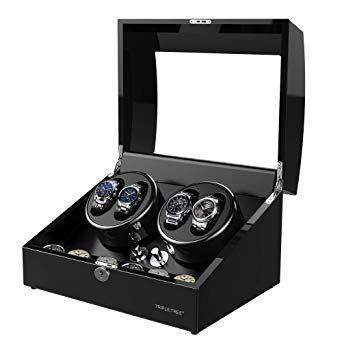
The movement of an automatic watch comprises a mechanism that causes the mainspring to get wound by making use of the movements of the wearer. The self-winding watch comprises a small weight which rotates on a pivot. When the watch is worn, the wearer’s movements cause the weight to turn on its staff that is connected to the ratcheted mechanism for winding.
The circular movement of the weight triggers a set of gears which cause the winding of the mainspring. When the mainspring is wound fully, it reserves sufficient energy so the watch can run if left stationary even for around 2 days.
There are various self-winding systems. Some mechanisms allow the watch to get wound when the weight moves in one direction, other more advanced winding mechanisms contain 2 ratchets and let the mainspring get wound when the weight moves in both the clockwise, as well as, the anticlockwise directions.
Self-winding automatic watches can also be manually wound by rotating the crown on the dial to keep the watch operational when not in use or if the wrist motion of the wearer is not enough to keep the watch wound automatically.
Electric Mechanical Watch
The electric watch made it first appearance on 19th March 1952 by LIP and Elgin National Watch Company and the electric watch was produced and retailed in 1957 by Hamilton. However, the electric watch phase was extremely short-lived, before quartz watches took the world by storm, thanks to their greater durability and accuracy.
Electric watches had a tuning fork or a balance wheel, which was basically the timekeeping element, which was electro-magnetically driven by a solenoid that was battery-powered. The hands of the electric watch were operated mechanically via a wheel train.
Types Of Electric Watches
- Moving Coil System - The watches that used this system essentially made use of a balance wheel with mechanical contacts, integrated coil and fixed magnets. Some examples of watches using this system are the Hamilton 500, Champion (UMF or Ruhla), Epperlein 100, Timex M40 and the Slava 114ChN.
- Fixed Coil System - The watches in this category used a piece of iron which was attached to the balance wheel, mechanical contacts and a fixed coil. The movements of some of the watches used a diode in order to reduce the sparking on the contacts and extend the life of the electric watch. Some of the fixed coil system watches were LIP Electronic R 27, LIP R 148, Landeron 4750 and Elgin Electronic 722, 725 and 910.
- Transistorized Watches - These watches comprised a balance wheel, no mechanical contacts and a transistor which acted as a switch. The base plate contained the coil, while the balance wheel had magnets. Some examples of transistorized watches are Laco 882, Timex M87, Seiko Electronics 31 A and Citizen X-8 Series.
- Watches with Tuning Forks - These watches used a tuning fork, which was driven by a solenoid that was powered by an oscillator circuit of one-transistor and it did not have any mechanical contacts. The tuning fork consisted of an index wheel and pawl attachment that turned the gear train. Some examples of these watches were Slava Transistor, Prim Elton, Omega F300Hz and the Speedsonics Series.
Electric Watch Milestones
- Hamilton: This was the world’s first electric watch to be manufactured and retailed.
- LIP: This was the world’s first electric watch that used a diode, an electric component in order to lessen the sparking on the contacts.
- ESA Dynotron: This was the world’s first electric watch that used a transistor and a balance wheel.
- Bulova Accutron: This was the world’s first electric watch that used a transistor.
Manual Mechanical Watch
A manual watch is a mechanical watch that is not self-winding or automatic, nor is it driven electrically. Typically, in a mechanical watch, the gears of the watch are turned by the mainspring, which is a spiral shaped spring.

A manual watch requires winding physically by hand to supply the power in order to run. The crown that is located on the side of the watch must be wound on a regular basis and this provides power for the watch to maintain the timekeeping function.
The energy is transmitted from the crown to the mainspring through the gear train and is stored in the mainspring. The wound mainspring tries to uncoil itself and release the power that is required to trigger the movement and this makes the watch tick.
The energy that is released is regulated by the balance wheel and the spiral so that the energy release is uniform, which causes the movement to be precise. The watch movement is powered by the energy stored in the mainspring until the power runs down and the spring requires winding again.
However, if you forget to wind the watch, then the energy that is stored runs out, which causes the watch to stop working. Once this happens, you need to wind the watch again manually and reset the time.
Most of the manual mechanical watches have a power reserve of around 40-70 hours, which means that the watch will require winding daily or once in a couple of days. High-end models have power reserves up to 7-10 days, as they have several mainsprings that power the movement.
What Does A Watch Winder Do?
A watch winder is essentially a device that keeps self-winding or automatic watches working even when they are not worn. An automatic watch winds itself by making use of a moving weight present inside the watch. When the watch is worn, the weight rotates or swings, thereby turning the winding mechanism within the watch.
If the watch is not worn for a while, then it does not receive power and will stop working. Although an automatic watch can be wound manually, it not very convenient to do so all the time and so, the automatic watch winder was created.
The watch winder holds the watch, sometimes many watches, and moves it in a circular manner that mimics human motion in order to activate the self-winding mechanism, so that the watch is ready to wear at any time.
How Does A Watch Winder Work?
If your automatic watch stops, it can be rewound and you can set the time and date. However, having to do this for several watches time and again can be quite annoying, as well as time-consuming. Using a watch winder helps to keep your automatic watches ticking and can eliminate the need for you to get the watch going again and again.
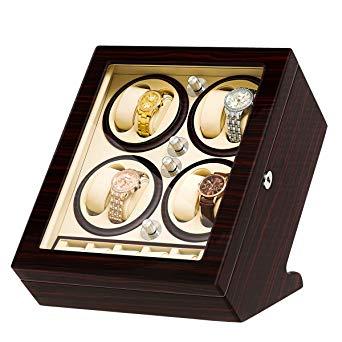
In a watch winder, the watches are strapped into a box or a brace. The winder has an electric motor which is battery-powered or it is powered by an adapter. The motor causes the winder to rotate constantly and this helps to keep the watches wound.
A watch winder helps to protect your delicate and expensive automatic watches from damage due to irregular use. The continuous rotation lets you monitor the precision of the watch gears and ensures that if your watch has a perpetual calendar function, then the calendar is set to the correct date even if the watch has not been worn for a long time.
There are different kinds of watch winders that vary in their functioning. Simple inexpensive watch winder models are operated by a single motor, while high-end models may have a separate motor for each watch. Some expensive high-end watch winders also have motors that allow you to set the number of rotations and the rotation direction as required.
Difference Between A Single Wind Box And Those That Can Wind Multiple Watches
The size of the watch winder you buy depends on the number of watches you own. If you own a single automatic watch and wear it most of the time, then just wearing it on your wrist is sufficient to keep the watch wound.
However, if you wear the watch occasionally, it is a good idea to buy a single watch winder that will keep your watch wound and ready for use at any time.
However, if you are a watch connoisseur and own many watches, then buying a watch winder with multiple slots to keep all your watches is a great idea. There are many types of watch winders available i.e. for 2 watches, 4 watches or multiple watches.
And, if you plan to expand your watch collection in the future, then it may be a good plan to buy a large automatic watch winder box that can accommodate several watches. These large watch winder boxes can be used for storage and also have the facility to lock your valuable watches to keep them safe.
Can watch winders overwind an automatic mechanical watch?
A watch winder cannot really overwind an automatic watch as almost all automatic watches are equipped with a mechanism that prevents them from overwinding. When the mainspring of the watch is fully wound, the mechanism of the watch halts the winding process and the watch stops getting wound.
However, buying a winder that is equipped with a timer is important in order to prevent the winding mechanism from getting worn out. Also, a watch does not require to be kept in winding motion 24x7, just half an hour of motion in a day is sufficient to keep your watch wound properly.
How To Use A Watch Winder
You can maintain the accuracy of your watch for a long time if you have a watch winder that is operating at the right setting. Ideally, your watch should run at the top 75% of the mainspring at all times, either when it is on your wrist or when placed in the winder to prevent any wear on the watch’s clutch.
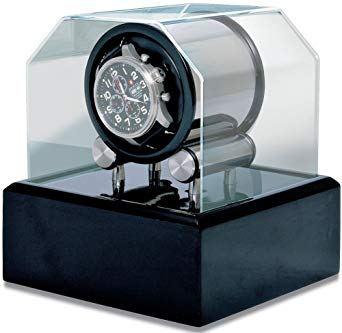
The mainspring of an automatic watch must be at 80-90% tension for it to be fully wound. While any normal activity keeps the winding at 50-60%, a winder will keep the watch wound at around 80%.
Ideal TPD
When you place a watch inside the winder, it requires a specific number of turns per day (TPD) or complete revolutions in 24 hours, to work best. Too few TPD means that the watch does not get wound fully and too many TPD increases the risk of the watch wearing out.
Typically, the default TPD setting of a watch winder is around 650 TPD. However, a high-quality watch winder allows you to set the TPD as per your requirement.
You must also remember that when you place your watch that is not fully wound in the winder which is set to the ideal TPD, the winder will not wind the watch fully. So, you must wind the watch manually first and then place it inside the watch winder. This will ensure that the watch is wound at the optimum mainspring tension.
Setting The Start Delay
Many watches have a power reserve that allows the watch to run for some time, even when you are not wearing it. A high-quality watch winder will allow you to set a start delay for the watch that you have worn recently.
The start delay function allows the reserve power to completely run down before the winder begins its winding action. This ensures that the watch is not over-wound in the long run.
Winding Direction
Most of the watch winders have a bi-directional turning, which means that the winder turns in a different direction in every cycle. Most of the watches work well with the bi-directional winding. However, some watches have different requirements i.e. clockwise or anti-clockwise turning, for instance. Some watch winders provide all the 3 settings.
Watch Winders As Display Cases
While the design of the watch winder does not have any bearing on its function or efficiency, buying an aesthetically designed box can make all the difference, especially if you are using it to wind a high-quality watch such as an Omega, Rolex or Tag Heuer.
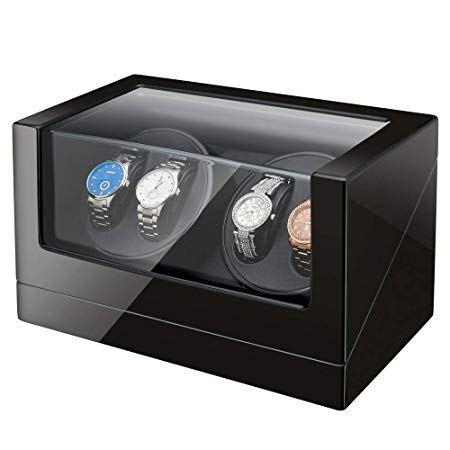
Several watch collectors use their watch winding boxes as display cases and select winders that enhance the aesthetics and craftsmanship of the watch.
While simpler and inexpensive watch winders may be made of materials such as metal, plastic, particle board, wood, etc., you can invest in buying a high-end premium watch winder that is made of kiln-dried premium wood, which is coated and stained to give it a high-gloss, durable finish. And, the kiln drying also prevents cracking or warping due to temperature and humidity.
You can look for a watch winder with a wood finish that complements the décor of your bedroom; however, you must make sure that the bottom of the case is lined with felt so that the surface of your dresser is protected. Also, ensure that the interior of the watch winder is lined with a soft fabric and the case has sufficient slots to accommodate all your watches.
These watch winders offer much more than simple functionality and they have an old-world charm about them that make them pieces of art that are worth displaying in your home on your dresser. Some watch winders can also be fitted easily into your drawer or in your safe deposit locker to keep your valuable watches safe.
Watch Winder Maintenance And Calibration Tips
Watch Winder Tips
A high-quality watch winder is essential to keep your automatic watch ticking. However, the maintenance of your watch winder is vital to keep it functioning efficiently. Here are some tips for the maintenance and care of your watch winder:
- Ensure that you wipe the outside of the watch winder box with a soft cloth and mild detergent to prevent any scratches on the polished surface.
- Ensure that the wood of the watch winder is of high-quality and that there is no moisture, as this can cause the wood to warp or crack.
- Make sure that the lid of the winder box and the hinges are aligned, so that the winder box can be closed properly.
- Make sure that the watch winder box is completely lined with soft fabric so that your watches are safe and not dented or scratched.
- Check the lining and padding on the underside of the watch winder box to prevent any scratching of your dresser or table where the watch winder box is placed.
- Clean the inside of the winder box carefully so that the working part of the device is not disturbed.
- Try and avoid any impact to the winder or avoid dropping it, as this can damage the working mechanism. And, if the watch winder does suffer a fall, then you should get it repaired immediately lest the working of the mechanism gets affected and this could, in turn, affect the winding of the watch.
- Keep the watch winder away from the reach of small children, who may damage the delicate mechanism of the winder due to improper handling.
- Place the watch winder in a cool shaded place and away from direct sunlight.
- Keep the watch winder away from magnets or any device containing magnets. Not only can the working of the watch winder be damaged by exposure to strong magnetic fields and high temperatures, these can also interfere with the working of the automatic watch.
Watch Winder Calibration Tips
- If the watch is not working, then wind the crown manually around 20-25 times.
- Then, place the watches into the individual slot in the watch winder box and make sure that it fits securely.
- Set the TPD to the lowest setting.
- Next, choose the bi-directional rotation mode.
- Turn on the power of the watch winder.
- Check the progress of the winding over the next 2 days.
- If the timing is not correct, then increase the TPD setting and begin from the first step.
- Monitor the performance of the watch for the next couple of days.
- If the timing is correct, it means that you have found the ideal setting.
- If the timing is incorrect, then set the watch winder to rotate in the anti-clockwise direction and repeat the entire process.
An automatic watch is a great buy; however, it will work only as long as it is worn on the wrist. A couple of days in the cupboard could cause your watch to stop. Shaking and resetting your watch every time can be a hassle and warrants that you buy a good watch winder to keep your watch in running condition.
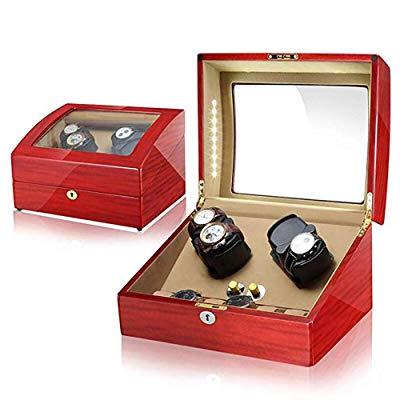
There are tons of options of watch winders out there, from inexpensive options that can cost you less than $50 to customized display cases that could easily cost thousands of dollars.
So, buying the watch winder that is right for you in terms of the quality, as well as cost, can be quite a challenge. Our buying guide can help you make a decision on the right watch winder for your precious automatic watch(es).
